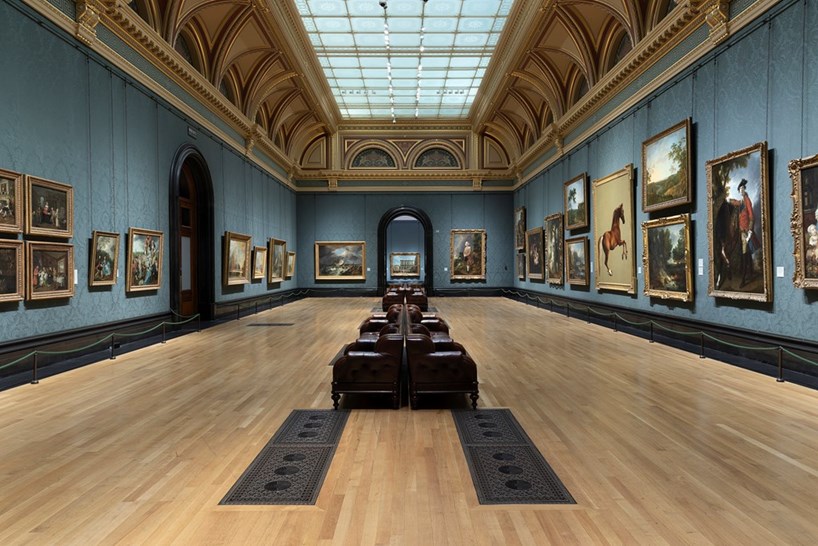GROWING up and being schooled in London, I have been privileged to visit the collections of the National Gallery over many years. In the 1970s, the development along Orange Street offered a new secondary entrance and galleries for colder Northern European art, and then in 1991 the revised “carbuncle”, as the then Prince of Wales dubbed it, opened as the Sainsbury Wing. I took a small parish group around that collection of Renaissance and early Gothic painting later that autumn, and have continued to take small parish groups ever since.
With the bicentennial year, the National Gallery has had the opportunity both to redevelop the 1991 building, and to provide more space for cafes and the restaurant, while retaining a small bookshop; and, with the support of CC Land Holdings Limited, a Hong Kong-based development and investment company with substantial interests in China, Hong Kong, and the City of London, it has undertaken a rehang of the entire collection.
The clever use of free-standing vitrines has opened up wall space; some thousand pictures are on display. The crowded walls of the National Gallery when at John Julius Angerstein’s house in Pall Mall before May 1834 are long a thing of the past.
Generous wall space around the pictures in the hang (sometimes a little too generous for the four portraits in Room 11, for instance) provides a more airy and open view. The refurbishment of the floors and introduction of oak furniture gives a contemporary feel to each room.
The Sainsbury Wing retains the early pictures, from 1260 to 1550; after two years’ closure, it is good to have them back in place. The central aisle, as it were (Rooms 57 to 60), is dominated by the painted crucifix of Segna di Bonaventura of c.1310, leading the eye to a reassembled polyptych on the farthest wall with the predella paintings of Fra Angelico set before them.
Seven of the eight scenes of the Life of St Francis by Sassetta frame a principal doorway, while side gallery rooms serve almost as side chapels. The Baptism of Christ by Piero della Francesca is back on its look-alike altar crafted in 1991 (Room 66).
The Holbein portrait of Erasmus bookends a wall in Room 54, with his 1526/28 portrait of (?) Anne Lovell, either side of Pieter Breugel’s 1564 stark Adoration of the Kings. It remains a regret that the opportunity has not been taken in the signage to identify more clearly which paintings belong to the Nation and which are on loan. If the Earl of Radnor decides to sell the Erasmus (L658), the point of this wall will go for nothing.
 © The National Gallery, LondonRoom 34, The National Gallery, “A Distinct Style: British Painting 1740-1800”; part of “C C Land: The Wonder of Art” View south into Room 33: “City of Pleasure: Painting in Venice 1700-1800”
© The National Gallery, LondonRoom 34, The National Gallery, “A Distinct Style: British Painting 1740-1800”; part of “C C Land: The Wonder of Art” View south into Room 33: “City of Pleasure: Painting in Venice 1700-1800”
While Whistlejacket by Stubbs and the Holbein Ambassadors of 1533 form end viewpoints of the crossing enfilades of the Wilkins building, other pictures deserve more careful searching out. The Venetian views of Canaletto and Guardi suggest something of an 18th-century salon (Room 33), whereas my guest observed that the French Impressionists were over-lit on the bright clinical walls of Rooms 43 and 44.
Best perhaps is the appropriate hang for the six Triumphs of Caesar, painted by Andrea Mantegna and loaned from Hampton Court, where they have long been difficult to see at a distance. When these first came to Trafalgar Square (Arts, 10 November 2023), the glare of overhead lighting made them equally inaccessible. Now, however, on either side of Room 12, albeit a corridor space, they can be seen in close detail. A 60-page illustrated booklet by Caroline Elam and Guido Rebecchini (2024) provides a good introduction to the paintings of c.1486-92.
In the central hall hang the much discussed portraits of our present King and Queen, unveiled on the second anniversary of the Coronation. If Paul S. Benney has made Queen Camilla look like a 1970s chanteuse, he has at least captured something of the vivacity of her face. At her side, the Peter Kuhfeld portrait of the King, who is patron of the National Gallery, shows His Majesty in a pair of crumpled uniform trousers, almost lurching up against a side table.
As with the 2013 image used of the King on current banknotes, this artist has done little to make King Charles recognisable. In terms of portraiture, there is more to learn about majesty from Titian, Rubens, and Van Dyck, whose work elsewhere in the galleries puts these in the shade.
“CC Land: The Wonder of Art” is at the National Gallery, Trafalgar Square, London WC2. Phone 020 7747 2885. www.nationalgallery.org.uk















